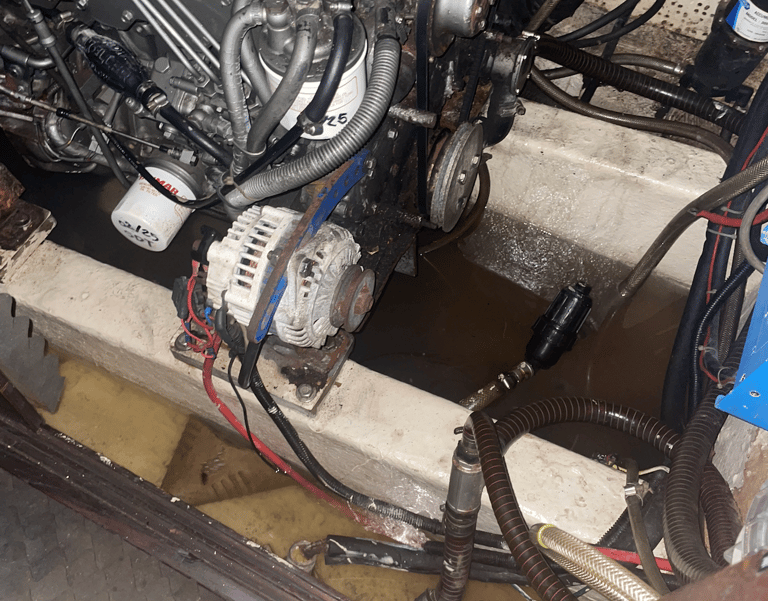Propeller Shaft Seal
What if your boat is suddenly full of water
3 min read
After we anchored in Moorea for the first time, it was already dark. At the end of our journey we encountered wind dead areas and had to use the motor to slowly maneuver through them and into the bay. After securing the boat, we were exhausted and went straight to bed. The next morning, I went to check the engine room as part of our routine checks and I froze for a second. The engine bay was full of water. I immediately turned on the bilge pump, heart racing. Something was clearly wrong.


It didn’t take us long to locate the issue. The leak was coming from the propeller shaft seal.
What is the propeller shaft seal? The propeller shaft seal is a critical piece of equipment in any boat with an inboard engine. It’s the only thing standing between the ocean and your boat’s interior at the point where the propeller shaft passes through the hull. The shaft, a metal rod, connects your engine to the propeller. This rod spins rapidly and must pass through the hull to do its job. Where it exits the boat, you need a seal that prevents seawater from entering while still allowing that shaft to spin freely. That’s exactly what the propeller shaft seal is there for.
There are several types of propeller shaft seals, each with its own advantages and drawbacks. The most traditional is the stuffing box, also known as a packing gland. This type of seal uses layers of braided packing material (often flax or a synthetic fiber) that are compressed around the shaft to create a watertight barrier. These seals are relatively inexpensive and simple to maintain, but by design they are supposed to drip slightly. That dripping helps keep the packing cool and lubricated. The downside is that the bilge is never completely dry, and too much water means either improper installation or wear. On the other end of the spectrum, there are lip seals, which use rubber-like lips pressed against the shaft to keep water out. These are compact and cleaner but have their own wear and alignment challenges.
We use a dripless shaft seal known as a PSS (Packless Sealing System), a type of mechanical face seal. This system uses two flat surfaces. One surface is rotating with the shaft and the other one is stationary. The sealing happens through the fact that they press tightly against each other. One surface is usually made of carbon or graphite, and the other of stainless steel. If installed and maintained correctly, they form an incredibly tight seal and allow for a dry bilge and smooth operation.
In our case, the seal wasn’t doing its job. Upon closer inspection, we realized the stationary carbon face and the rotating steel face were no longer being pressed tightly together. Over time, the clamp holding the assembly in place had shifted, loosening the whole unit. As a result, when the engine ran and the shaft began to rotate, the slight separation allowed seawater to enter the boat. Most likely, most of that water had come in while we were motoring into the bay the evening before.
Once we understood how the seal operated, the fix turned out to be relatively simple. We loosened the screw securing the Self-Aligning Shaft Clamp and gently shifted the entire unit backward to restore the necessary tension between the two surfaces. To ensure the adjustment would hold and to track any future movement, we marked both the new and original positions on the shaft using a permanent marker. The next time we used the engine, everything worked perfectly, no more leaks.
As an extra precaution, we’re considering adding a hose clamp just behind the seal. This would act as a mechanical stop and help prevent the seal from creeping forward again over time.
What started as a scare turned into a valuable learning moment. Sometimes a screw just a bit too loose can lead to dire outcomes.
📚 Our Book Recommendations for Drivetrain Troubleshooting
If you're trying to understand or fix issues with your drivetrain, including learning more about the different types of propeller shaft seals, these two books have been absolute game-changers:
🔧 Boatowner’s Mechanical and Electrical Manual by Nigel Calder
We can’t recommend this book enough. It covers everything that can break on a boat, and how to fix it. Without it, troubleshooting would’ve been so much harder. It helped us understand what’s normal, what’s not, and how to take action. 👉 Buy from Amazon (Ad)
⚙️ Marine Diesel Engines by Nigel Calder
This one does a deep dive into all things diesel. It breaks down different engine designs, their pros and cons, and how to troubleshoot like a pro. If you're curious about propeller shaft seals, it lays out the different types and what to look out for. 👉 Buy from Amazon (Ad)
If you’d like to read more, follow our journey, and support what we do, don’t forget to subscribe to our newsletter or follow us on social media. Every bit of encouragement helps keep the adventure going and we’d love to have you aboard!
